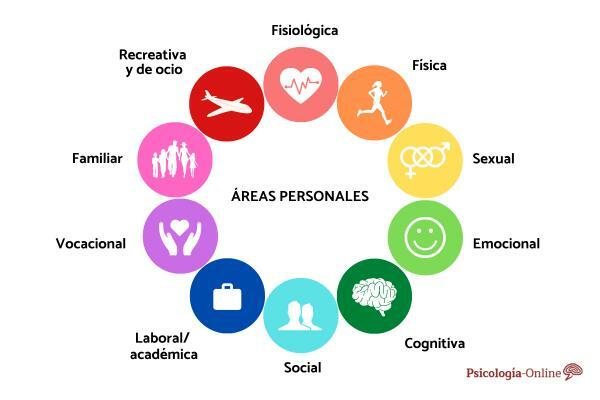
If we observe the behavior of a group of people in the face of any event in daily life, it is quite common to appreciate that there is no total coincidence between them, the normal thing is that they present differences and, sometimes, opposite behaviors are manifested (if the various behaviors in fairly large groups of people, it can be seen that they are always distributed in a curve of the type of bell of Gauss). It is enough to listen to the comments of the assistants to a movie to hear different opinions and different feelings between them.
The same goes for any commercial product launched on the market or voting intentions in an election. It is very difficult to achieve uniformity. This prompts us to ask ourselves: why don't all people respond and act the same when faced with the same event? If they are all sharing the same environment? Why does it affect some emotionally more than others? Where do these personal differences lie?
Keep reading this PsicologíaOnline article if you are interested or interested in solving the question of
Index
- Functions of diversity
- Why don't we all have the same opinion?
- Why don't we feel the same
- Why don't we choose the same answer?
- Conclution
Functions of diversity.
A first approach to these questions is to find out if this diversity fulfills any function or it has some use and, in turn, if it is necessary and essential that there is a diversity of behaviors in human groups that coexist in the same environment.
A solidly supported answer can be obtained from the observation of Nature. If we look at the natural systems that surround us it is easy to see that there is a great diversity of forms, structures, functions, relationships, etc. that give rise to different rituals, functions and behaviors, which leads us to the conclusion that Nature, to preserve the survival of biological systems, has imposed the strategy of diversification versus uniformity (The animal and plant world is divided into numerous genera, species, families, each with its own rituals and behaviors). This strategy translates into the tendency for behavior to cover the full range of possibilities allowed by the nature of the acting biological system itself and the environment in which it lives.
In this sense, one of the principles of General systems theory notes that: “The behavior of a biological system depends on its physical nature and the conditions of the environment where it takes place. These elements provide the number of permitted behaviors -degrees of freedom- that can occur ”.
If we look at the behavior of physical systems, such as tossing a coin, it has two possibilities (two degrees of freedom): heads or tails, and the probability of each one is 50%, however, the fact that a certain head will come out if what we throw is a six-sided die is of 16%. But what happens when the elements that make up a dynamic system have numerous degrees of freedom, that is, when there are many possible states? In these cases a multitude of different possibilities may appear. This situation, translated into the behavior of biological systems, results in the ability to present a great diversity of different responses to the same stimulus by virtue of the degrees of freedom allowed to the type of system.
In the case of the human species, it is evident that being a dynamic and complex biological system, the number of degrees of freedom, that is, the number of possible responses that can be generated to an event is enormous. In view of this, it can be said that the diversity of behaviors in the face of the same event is a "natural" and "normal" phenomenon, the "abnormal" would be uniform behavior. Only in small groups of people and in the face of very simple events or those covered by some physical law (for example, the fact that throwing a stone upwards will undoubtedly fall) it would be more likely to reach the uniformity. Following this approach, it is easy to see that, when faced with the same event:
- Not all of us have the same opinion.
- Not all of us are emotionally affected with the same intensity.
- We do not all choose the same answer.
A relevant aspect to take into account is that human behavior is not deterministic and, unlike the rest of animal species whose behavioral possibilities are very limited, it enjoys a high number of degrees of freedom. However, the mere observation of people's behavior allows us to affirm that it is not chaotic, there are certain patterns of behavior that are They repeat quite frequently, so there must be some mechanism that organizes behavior and is common to the human race, that is, there must be instructions that the mind follows to organize and direct the behavior of people, and are the differences in these instructions (which in their together they would form a kind of "operating system" similar to computer processes) the factor that defines the singularity of the behavior of each person.
Since human behavior is not totally determined or chaotic, it must be treated from a probabilistic perspective given its sensitivity to changes, since our life develops in a supersystem where elements and relationships abound complex among all, so that a single change in one of them can cause a great change in our lives (a dismissal from work It can affect self-esteem, family, work or friendship relationships, the domestic economy, leisure activities, etc.). The behavior in response to an event does not have to be always the same, because by changing the circumstances of the person or the environment, the response can change (both are changing continuously, since they are dynamic systems, and the existence of certain patterns of behavior only serves to increase the probability that the behavior marked by the pattern will occur, but not necessarily).
Considering the previous approach, one way to face the question of the diversity of behaviors would be to focus on the mental phenomena involved and the personal differences that can be seen in each from them. Among the most relevant phenomena, following the order of mental processing of the information, are: perception, interpretation, evaluation, choice of response and impulse to action. The analysis of these processes will give us clues to understand why people think, feel and, consequently, act differently when faced with the same event.
Why don't we all have the same opinion?
In principle and following the above, the answer seems simple: because it is very likely that we do not perceive the same information of the event and / or because we do not give the same meaning to what perceived. Let's take a look at each of these factors:
The perception of the environment
Perception from the environment through the sensory organs is the gateway to our biological information system that it shows us. These organs are in charge of receiving the stimuli from the environment that mark the aspect of the concrete world that we perceive, an aspect that is typical of the human being, since other animals with sensory organs different from ours, perceive the world differently from the our. The essential factors of the perception process are the selection information (through care) and coding Y organization in neural frames of the same.
Each person selects and organizes information differently by virtue of what is perceived and her particular brain structures. A first difference is in the amount of information that the person captures from the perceived stimulus (inputs), that is, from their range of apprehension, which is the amount of information correctly identified and remembered after a brief sensory exposure (vision, hearing, etc.) that generates a factual representation of reality in the mind. As the sensory organs in charge of perception present differences in each person (they depend to a great extent measure of their DNA), they will also have different capacity to capture stimuli (images, sounds, tastes, etc.). Likewise, as it is not possible to apprehend all the immense amount of information available about an event, through the mechanism of the attention the sense organs pick up only a specific part of it, which is the part that is considered most important and that it can process effectively and, by virtue of this, it will obtain more or less information (in a room one person can capture ten objects on which he fixes her attention, while another can fix it on twenty, which increases the information inputs to process).
It is also easy to appreciate that the perceived external stimuli of a specific event are never identical for two or more people who observe it as they are linked to space and time. A natural property of matter is extension, that is, every material thing is extensive, it has mass. In consecuense, two objects cannot occupy the same space at the same time, Therefore, two people who at the same time observe a thing, do not have the same perception of it, because they are viewing from different spatial points and from different perspectives, and with this, you will obtain information about the environment different. In the same way, if two people occupy the same place but at different times, the perception of this place will not be the same either, because between one moment and another there will have been changes in the environment. The necessary diversity in terms of the information received gives rise to the perception differences (dp).
The interpretation of the information
The second step is interpretation of the perceived information. The factual representation of the reality obtained in the previous process must be integrated and "coupled" in a coherent way with the stored information. in the memory related to the event to obtain a meaning of it (the brain mixes the stimuli that it perceives with other thoughts and emotions stored in memory, as neural circuits intermingle, generating subjective interpretations of reality, that is, the person sees "its" not really "the" reality, although normally both tend to coincide).
This work involves mental mechanisms of great importance (a kind of "cognitive operators") such as logic, deduction, induction, algorithms, semantics, syntax, etc. The processing of incoming information together with that stored in the memory formed by the knowledge, experiences and experiences of the person related to the event constitutes the substrate of the mental program whose mission is to coherently group and relate the data necessary to form the psychological representation of the event perceived and whose interpretation will generate a meaning. But the interpretation is not based solely on cognitive operations on the available information, it also includes in them the beliefs assimilated and consolidated as a result of these relationships and, in addition, intervene the values that guide the person in their relationships with the environment (freedom, respect, honesty, trust, etc.) and the place they occupy in the hierarchy of values of each person.
The interpretation of events is of great importance in people's behavior, since they do not respond directly to the stimulus, but to its meaning. In this sense, it should be noted that in nature there are no concepts such as suffering, honor, loyalty, justice, friendship, etc. All of them are the creation of man and, therefore, subject to different interpretations and, although there is usually a coincidence in the semantic meaning of These concepts, the difference can arise when relating them to a specific event, because while an event is a physical reality observable by anyone (and exists even regardless of whether there is someone who observes it), the interpretation of it is a mental phenomenon that depends of the observer, and according to their knowledge, experiences, experiences, value system and the environmental circumstances surrounding the event, they will assign a meaning.
The key is in how all the available information is processed in the brain of each person and it depends of the instructions that contains your "mental program" for interpretation and of processing capacity of the mind (ability of neural networks to rapidly and efficiently facilitate the transit of the flow of information through the different brain structures) to establish relationships between concepts and configure a meaning.
We must also take into account the existence of emotional aspects associated with experiences acquired during life and related to the event that provoke an emotional reaction to its presence. The emotional state favors an interpretation of a stimulus that is consistent with this state. Emotions are large enough to impose themselves on a "logical" interpretation and can cause distortions in the way the brain interprets what we perceive, making it more likely that an emotionally charged interpretation will be applied to it before than a more realistic one (a clear example is the behavior of people in love, who can justify inappropriate actions of the other).
Given that the variables involved in the interpretation process: knowledge about the matter, experiences, beliefs, values involved and emotional biases can present differences in each person, the processing of the information for the interpretation will give place at differences of meaning (ds).

Why don't we feel the same
Because the emotional affectation depends on subjective assessment that the event has for us, that is, how it affects us on a personal level. The person can associate the meaning obtained with immediate or future consequences for himself or her environment, which may be positive or negative, transcendent or inconsequential, simple or complex, pleasant or unpleasant, etc., and manifested in the form of emotions. It must be taken into account that when people explain an event, they project their own needs, impressions and evaluations onto it. The same event, such as the death of a person, can be understood as a negative event for the family members attending the common consequences that such a situation entails, but if any of them were interested in inheritance, the event will be encouraging.
If we focus only on the area of events that we value negatively and cause disturbances of psychological stability, We observe that when an event generates a meaning that is considered by the person as harmful: dangerous, harmful, threatening, harmful, etc., either because harmful consequences have occurred or because they may involve future damages, this information is transmitted to the emotional system (SE), and this activates the corresponding physiological processes: alteration of the heart rhythm, respiration agitated, upset stomach, sweating, poor concentration, mental fog, irritation, etc. The question then is to find out what type of information the cognitive system has to transmit to the emotional system and what conditions must exist for the latter to be activated. It is necessary to emphasize that, like the environment that the person perceives, that is, the physical world that surrounds him, it is colorless, odorless and insipid and it is she through mental processes that covers it with color, aroma and flavor, the events that take place in it have no meaning or valuation per se, it is also the person who interprets, qualifies and values them through mental processes corresponding. For the emotional system to be activated, two conditions must be met:
Qualify the situation as harmful (dangerous, threatening, etc.).
That the magnitude of the negative assessment is sufficient to activate the emotional system.
In light of this, one of the important questions is to find out why an event that, as we have said, does not has value per se, acquires an emotional intensity capable of activating SE, which leads us to the concept from sensitivity of the same. In General Systems Theory, sensitivity expresses which are the variables that have the greatest influence on the behavior of a system, and are obtained from the response that this system gives to minimal changes of certain parameters. These parameters are given by the homeostatic interval of the system itself, so that if they are exceeded, the disturbance occurs. Faced with external disturbances, the sensitivity of the system is a very important factor to take into account.
In the human being, as a biological system, it is also sensitive to homeostatic variables that in the realm of the mind constitute psychological homeostasis, and that we could define them as “those variables of a psychological nature that must be considered to explain why a specific situation is capable of disturbing the balance psychological". The psychological homeostatic variables (VHP) constitute the pillars of the psychological stability of the person, they are created throughout life, can be modified over time and define what aspects of life are important and must be taken into account to maintain balance psychological. In addition, they are consolidated in the emotional memory during the maturation process of the person.
Each person is sensitive to specific VHPs that respond to the needs considered by them as fundamental, and among them are:
- Health and physical integrity; satisfactory personal relationships (love, affection, affinity);
- beliefs (religious, moral);
- family, employment or economic stability;
- value system: freedom, dignity, trust, responsibility, respect, honesty, sincerity, etc .;
- self-esteem;
- self realisation;
- prestige, recognition and social acceptance (belonging to the group), perception of control, etc.
But the violation of some VHP, although it is necessary, is not enough to activate the SE. It is also necessary that the "affective burden" of the event (it is a parameter that records the importance and significance of the negative consequences associated with this) is required for the SE neurons to activate, and for this it must get over the neuronal activation threshold and generate transmission between SE neurons, because if the stimulus is not sufficiently intense or lasting it will not be activated. It is clear, for example, that the loss of an anonymous life due to a plane crash in a foreign country is not the same, for which you can feel sorry, compassion, anger, etc., but it will not activate the SE to the level of disturbance, that if the victim is a close family member, in which the emotional disturbance will be very intense because the greater degree of connection with the deceased person and its significance in our lives increases the intensity of the affectation emotional. This threshold indicates the sensitivity of the emotional system to these types of situations, that is, how far we can endure an adverse situation without getting upset emotionally (there are people who get angry and irritated easily, are upset by any setback or setback, and others need stronger stimuli, more transcendent).
The sensitivity of the emotional system to capture the signals of the cognitive system and transmit them to the associated brain structures (mainly the system hypothalamus-pituitary-adrenal cortex), that is, the ease with which both systems communicate, basically depends on the number of neurons and the connections between them that intervene in communication, and the amount of neurotransmitters and receptors that facilitate synapses, and all of them depend fundamentally on the genetic makeup of the person, which directs the initial neural network, and the experiences during his life that can create new connections or modify the existing. For this transmission to occur, it is necessary to exceed the threshold threshold for activation of the intervening neurons.
There is therefore a relationship between the "affective burden" provided by the assessment of the event by the person and the sensitivity of the neurons of his emotional system, that is, of his threshold of activation. The sensitivity of the emotional system is an innate characteristic that depends on its genetic endowment, but what causes the emotional alarm to “go off” is learned, since it depends on the classification of the stimulus as harmful and with sufficient intensity to exceed the threshold of activation of the SE (however, this relationship is not always fulfilled, we all know people who are emotionally upset in situations that are objectively inconsequential and innocuous, even they themselves recognize that they would not have to be upset, but they cannot avoid it). In view of the above, the different emotional affectation between the people who are subjects of the same event will be given by the different possibilities that these factors (affective load and neuronal sensitivity) may present in each person, which are constituted in the valuation differences (dv).
Why don't we choose the same answer?
Once the interpretation of the perceived fact has been obtained and its consequences evaluated, the phase of choosing the appropriate response to it is activated. One aspect of great relevance when making this choice is to be clear about the goal or purpose (purpose) of the same. If the objective is simple and not of great significance, it is usually accomplished through a rapid rational process (intuition can be used). But when it comes to complex events or situations: choosing a profession, achieving a personal project, solving a conflictive issue, carrying out a task life, adapt to a situation, etc., before making a decision it is necessary to process and assess a large number of inputs (knowledge, experiences, emotions, values, motivations, expectations of achievement, difficulties, etc.) and conceive a large number of possible responses (outputs), as well as foresee the consequences of the themselves. All this is done through the process of reasoning.
But in decision-making, in addition to cognitive processes, emotional aspects can be present that exert a great influence on them. It is proven that the decisions people make are not always based on objective rational approaches, many are usually accompanied by an emotional component that greatly influences and can distort, and even nullify, the choice of behavior that, from a "rational" or "objective" point of view, contains a greater expectation of success.
An example of the influence of the emotional system on decision making is the natural aversion to the loss of some important element of a person's vital status (includes aversion to risk) that acts as a powerful conservative force and favors only minimal changes in the same. This emotional effect is observed in the fact that the feeling of happiness and enjoyment for a gain is lower in intensity than the irritation, bitterness or grief over the loss of something of the same value (no one likes to lose, whatever the value of the loss).
Similarly, many people, at the thought of great loss, experience a sense of anguish and deep pain, and the hope of a The minimal possibility of avoiding it leads to decisions that worsen the situation even more (for example, resorting to a healer when faced with a disease terminal). It is also important to inhibit the natural tendency to make decisions based exclusively on the immediate benefit, without taking into account that in the long term it can be harmful and revert to losses. For all this, it can be said that all behavior pursues a goal, and people set their goals based on their needs, desires, illusions, etc. and their perception of their personal capabilities and expectations of achieving them. Since these factors may be different, the goal differences (c).
Once the decision-making process has been carried out and the option that we consider most appropriate has been chosen, as well as the required planning To carry it out, the last step is to execute it, that is, for the decision to be manifested in the environment through the conduct. This requires an order that activates the motor system, a mental force (supported by motivation, intention and attitude) that prompts us to carry out the intended action and overcomes the inhibiting mental forces that incite inactivity. Among the latter, the most common are laziness, shame, insecurity, fear, etc., which often lead to acidia and procrastination. At this point, the different motivational forces that generate the impulse towards a certain behavior must be taken into account (such as need, obligation, emotion, utility, inertia, etc.) and as not all people act the same forces in a given situation, as it will depend on personal circumstances and the influence of the environment, they are generated the motivation differences (dm).

Conclution.
According to this approach, it is easy to admit that if an event contains a certain number of bits of information and not all people capture the same number of them or process them in the same way. In this way, what each one understands by the reality of the event that acts as a stimulus will be different, and so will the emotional response, and as a consequence the behavior chosen before it (not Any interpretation is necessarily followed by an emotional affectation, but each behavior must be preceded by a cognitive process, no one acts by itself, without more, even if it is minimum).
The mathematical expression of the diversity of behaviors, that is, the number of possible behaviors before an event, will be given by a mathematical function (f) that encompasses the differences resulting from the five processes described according to the degrees of freedom allowed associated with each one from them:
f (dp, ds, dv, do, dm)
Observing this function, with the large number of variables that it encompasses as we have seen, it follows that it is not very likely that there can be total uniformity in the responses of a group of people before a certain event (unless the group is very small or the event is very simple) since "the reality" that emerges from the processing of the information for each of them will be different (the probability that a large group of people will interpret a certain event in a homogeneous way and, in Consequently, they have the same performance, decreases as the amount and complexity of the information to be processed in their brains increases and the degrees of freedom allowed for each variable). It must also be taken into account that not all variables have the same weight in each person when culminating in an answer, and that the same answer can be generated from different interpretations, objectives and motivations.
However, putting this function into practice poses great difficulties, because the mind does not work in computable form (This is what the physicist and mathematician R. Penrose), there is no (at least for now) an algorithm that solves all the questions that affect the functioning of the mind and the mental phenomena (the evolution of the nervous system in animals has been adding new behavioral options, that is, a greater number of degrees of freedom, to create in man a system so complex that it escapes even systems based on algorithms). This is mainly due to the fact that the algorithms consist of a single and unquestionable reality (real numbers, for example) and are deal with the same operating system (precise instructions that cannot be ignored), while the mind works with a reality "Subjective", a personal "database" (semantic and episodic memories) and an "operating system" with different processing capacities depending on the person.
But this heterogeneity does not imply that there is necessarily and necessarily a different behavior for each person. Faced with this natural tendency to diversity, there is also a tendency in Nature to associate individual biological systems. in groups, which encourages the existence of certain uniform behavioral responses that allow and maintain the internal cohesion of the group (according to the General Systems Theory there is a natural tendency to group biological systems in response to entropic force thermodynamics). This peculiarity is explained on the basis that both are complementary strategies of Nature that are aimed at the survival of the species. In addition, the grouping of individuals generates emergent properties that the isolated individual does not possess and that are important for their survival.
If we accept that differences in human behavior are the result of the "diversity strategy" imposed by Nature and the innate and acquired variables of the person mentioned above, we should also accept that they can occur between the people of the group in which we coexist attitudes and behaviors that are different and even contrary to ours, since they are "natural" and "expected" as a result of these differences, thus avoiding misunderstanding, discrimination, interpersonal conflicts, intolerance, etc., and enhancing the natural mechanism of empathy towards them, considering them "Different" instead of "contrary" to us (unless, of course, the conduct is "unnatural" or socially reprehensible). Likewise, if these variables could be known quickly, easily and truthfully in each person, the work of psychotherapists would be more easy and accurate, as well as that of sociologists when interpreting the behavior of human groups in the face of certain events.
This article is merely informative, in Psychology-Online we do not have the power to make a diagnosis or recommend a treatment. We invite you to go to a psychologist to treat your particular case.
If you want to read more articles similar to Why do people think, feel and act differently when faced with the same event?, we recommend that you enter our category of Personality.
Bibliography
- Bertalanffy, Ludwing. General systems theory. Madrid. Editorial Alliance, 1982.
- Penrose, Roger. The Emperor's New Mind. Barcelona. Random House Mondadori, 1991.
- Pinker, Steven. How the mind works. Barcelona. Destino Editions, 2000.
- Rosenzweig, Mark R. and Arnold I. Leiman. Physiological Psychology. Madrid. McGRAW-HILL, 1992.


